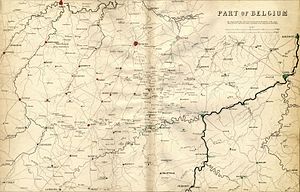Waterloo Campaign: Ligny through Wavre to Waterloo
| Waterloo Campaign: Ligny through Wavre to Waterloo | |||||||
|---|---|---|---|---|---|---|---|
| Part of The Waterloo Campaign | |||||||
 A portion of Belgium with some places marked in colour to indicate the initial deployments of the armies just before the commencement of hostilities on 15 June 1815: red Anglo-allied, green Prussian, blue French |
|||||||
|
|||||||
| Belligerents | |||||||
|
|
|
||||||
| Commanders and leaders | |||||||
| Napoleon, Marshal Grouchy | Prince Blücher | ||||||
| Strength | |||||||
| French Army Order of Battle | Prussian Army Order of Battle | ||||||
After their defeat at the Battle of Ligny (16 June 1815) the Prussians successfully disengaged and withdrew to north west to Wavre where they reorganised and then three corps advance westward to attack the right flank of the French army at the Battle of Waterloo. The French were desultory in the aftermath of Ligny. Napoleon wasted the morning of 17 June by taking a late breakfast and going to see the previous days battlefield before organising a pursuit of the two Coalition armies. He took the reserves and marched with Marshal Ney in pursuit of the Duke of Wellington's Anglo-allied army, and he gave instructions to Marshal Grouchy to pursue the Prussians wherever they were going and harry them so that they had no time to reorganise.
Both Napoleon and Grouchy assumed that the Prussians were retreating towards Namur and Liege, with a view to occupy the line of the river Meuse, and so during 17 June Grouchy sent the bulk of his cavalry ranging in that direction as far as Perwez. In his despatch to Napoleon written at 22:00 he was still thought that most of the Prussian army was retreating north-east, although he by then realised that two Prussian corps were heading north towards Wavre. In a second dispatch written four hours later he informed Napoleon that he now intended to advance either on Corbais or Wavre. The problem for the French was that by the end of 17 June, most of Grouchy's detachment was now behind the Prussians, on the far side of the Dyle. This meant that they were incapable of preventing the Prussians moving from Wavre towards Waterloo and too far away themselves to go directly to the aid of Napoleon on 18 June should Wellington turn and fight south of Brussels.
On the morning of 18 June those Prussians who had not already done so crossed the Dyle in and around Wavre and headed westwards towards the Waterloo battlefield. Grouchy was at Sart-lez-Walhain when at about 11:30 he and his staff heard the sound of cannonades in the distance, which a local notary said sounded as if it was coming from what is now known as the battlefield of Waterloo. This was in a north-westerly direction, at a distance of about 23 kilometres (14 mi) as the crow flies, with no direct roads between Grouchy's position and the battlefield. The distance to Wavre (nor'-nor'-west) was about 13 kilometres (8.1 mi) with some larger minor road leading there. After considering his options, Grouchy decided to advance to Wavre and engage whatever Prussians he found there, and so aid Napoleon by preventing those Prussians from moving towards Waterloo.
...
Wikipedia
